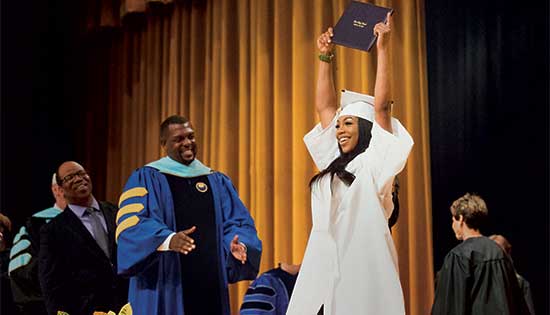A changing landscape: religion and spirituality on campus
A changing landscape:
Religion and spirituality on campus
Often students drift away from their religious roots when they get to college. It’s not surprising, especially considering the demands of a rigorous academic life, the draw of new friends and social activities, and the fact that they are away from their families.
What’s changed, however, is that many of today’s students enter college without any kind of religious affiliation. This is the case for 31 percent of college students today, as compared to just 10 percent in 1986.* At the same time, the religions with which they can choose to affiliate are growing in number, and many students are interested in exploring mindfulness, meditation, and spirituality as well as learning about the faith of others.
A spiritual home
Since 1970, the University of Rochester’s Interfaith Chapel has welcomed people of all faiths to share in dialogue, worship, and interfaith education. For many years, the chapel primarily served Christian and Jewish groups.
Today, students come from all 50 states and 70 countries, and nearly 20 percent are underrepresented minorities. The chapel serves ten faith communities and several student-led faith groups such as the Agape Christian Fellowship, the Hindu Students’ Association, and the Student Association for Interfaith Cooperation. The Catholic Newman Community and Hillel remain the largest faith communities, and an active Muslim Students’ Association has become the third–largest, regularly drawing 60–80 students every Friday for prayers.
“I love bringing together students from different religious traditions, and students from no tradition, to find the things that they have in common.”
—Denise Yarbrough, director of religious and spiritual life
Since Denise Yarbrough began in 2012 as the director of religious and spiritual life, she’s ushered in many changes to better serve the University’s increasingly diverse student population, including a 2015 chapel renovation to accommodate the increasingly diverse religious and spiritual communities on campus.
Wooden pews were removed to accommodate varied prayer practices, and the stone dais (raised platform at the front of the sanctuary) was removed and replaced by one that is wooden, movable, and handicapped-accessible. A new hearing loop was installed to improve the quality of sound for the hearing-impaired as well. “We needed to make it user-friendly for the many groups who worship in this space,” adds Yarbrough.
Yarbrough also expanded what’s become a thriving student intern program. The current group of interns represents distinctly different religious backgrounds and hails from Mexico, New York, Pennsylvania, Senegal, and South Africa. The interns lead the Students’ Association for Interfaith Cooperation and are assigned as liaisons to each religious group.
Interns also support events, which may be designed for a particular religious tradition, but often draw in unaffiliated students. For example, Hijabi for a Day was an event that provided an opportunity for non-hijab wearing Muslims and non-Muslim women to wear the hijab (a head covering worn by some Muslim women). Holi Study Break is another example. This event recently drew more than 100 students for “color throwing” to celebrate the Hindu Festival of Color.
Outgrowing the chapel
The chapel accommodates much of this wide-ranging activity, but on a campus that has seen the undergraduate student population grow by 30 percent since 2006, the space is feeling the squeeze.
By necessity, many groups hold meetings, events, and services in Wilson Commons, Douglass Commons, and other campus locations. Newman and Hillel are both seeking to establish supplementary space to serve their respective faith communities. Learn more about Newman’s efforts here.
*Source: CIRP Freshmen Survey
“The community that I have found at Hillel has enhanced my experience at Rochester in countless ways. It has encouraged my Jewish learning, enhanced my spiritual connection to Judaism, and given me a network of lifelong friends.”
—Rebecca Royzer ’16, ’20M (MD)
How you can help
As the University’s campus continues to diversify and grow, so will the spiritual needs of students here. To learn more about how to support the many faith communities at the University, contact Lisa Hall, Executive Director of Advancement for the College, at (585) 273-3619. You can also make a gift here.
—Margaret Bogumil, June 2018





